Background and history
A box of Leonard's malasadas, and the remains of one
Margaret and Frank Leonard Rego Sr. opened Leonard's Bakery in 1952. Rego's mother had encouraged him to sell malasadas, [1] a holeless Portuguese doughnut with a "crispier" outside and a "chewier" inside. [2] Portuguese plantation workers brought the dessert to the Hawaiian islands when they immigrated at the turn of the 20th century. Leonard's is known as an "old-fashioned, plain-Jane bakery" [3] that popularized pastries and desserts in Portuguese cuisine, like Portuguese sweet bread and pão doce meat wraps, [2] sometimes with a Hawaiian cultural borrowing like haupia, coconut, and guava filled malasadas. [4] [5]
As of 2011, the bakery remains a family business owned by Leonard Rego Jr. whose own children participate in its operation just as he once did. [6]
Andrew McCarthy of the National Geographic Traveler wrote that the bakery is an institution that "anchored" its neighborhood. [7] In Hawaii, Leonard's is a "household name". [8] Residents from the other Hawaiian islands often bring home Leonard's malasadas as an omiyage (souvenir gift). [9] The fried doughnut-like item may be unique to Hawaii, [9] but are well known both in the continental United States and internationally. [10] [11] [12] [13] [14] The Honolulu bakery is a point of interest on at least one island tour. [15] In 2012, the Honolulu Star-Advertiser reported that the bakery sold over 15,000 malasadas daily, or over 160 million since its opening. [1] [lower-alpha 1]
Rego Jr. opened a franchise location in Japan's Yokohama World Quarter Shopping Center in December 2008. The location only sold cinnamon and sugar malasadas at first, [16] but later added malasadas with fillings. [17] Japanese investors Forest Inc. first asked Rego Jr. about licensing the brand in March 2008, and Rego Jr. felt that the timing with the Great Recession "couldn't have been more perfect". [16] The deal was completed three months prior to the opening, and the owner flew in to train the staff for a week and a half. Rego Jr. plans to open more franchised locations in Japan and on the other islands of Hawaii. In 2009, the company employed 60 people between three stores (two in Oahu and one in Yokohama) and two Oahu food trucks. [16]

American Chinese cuisine is a cuisine derived from Chinese cuisine that was developed by Chinese Americans. The dishes served in many North American Chinese restaurants are adapted to American tastes and often differ significantly from those found in China.

A doughnut or donut is a type of pastry made from leavened fried dough. It is popular in many countries and is prepared in various forms as a sweet snack that can be homemade or purchased in bakeries, supermarkets, food stalls, and franchised specialty vendors. Doughnut is the traditional spelling, while donut is the simplified version; the terms are used interchangeably.
Jamaican cuisine includes a mixture of cooking techniques, flavours and spices influenced by Amerindian, West African, Irish, English, French, Portuguese, Spanish, Indian, Chinese and Middle Eastern people who have inhabited the island. It is also influenced by the crops introduced into the island from tropical Southeast Asia, many of which are now grown locally. A wide variety of seafood, tropical fruits and meats are available.

Saimin is a noodle soup dish common in the contemporary cuisine of Hawaii. Traditionally consisting of soft wheat egg noodles served in a hot dashi garnished with diced green onions and a thin slice of kamaboko, modern versions of saimin include additional toppings such as char siu, sliced Spam, sliced egg, bok choy, mushrooms, or shredded nori. When Chinese dumplings are added to the noodle soup, it is seen on menus as the heartier wonton min. All saimin establishments have their own, often secret recipe for the soup base, but primarily use kombu and dried shrimp as major ingredients. Common table condiments mixed in the saimin broth are Chinese hot mustard and soy sauce, added in small quantities according to each individual's taste. Many local residents of Hawaii also enjoy barbecued teriyaki beef sticks (skewers) or American hamburgers as a side dish.
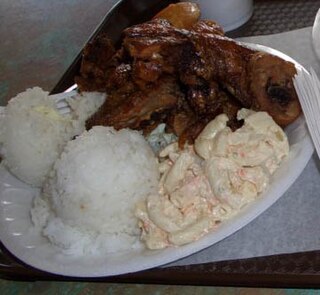
The plate lunch is a quintessentially Hawaiian meal, roughly analogous to Southern U.S. meat-and-threes. However, the combination of American and pan-Asian influence makes the plate lunch unique to Hawaii.

The cuisine of Hawaii incorporates five distinct styles of food, reflecting the diverse food history of settlement and immigration in the Hawaiian Islands.[a]

A Krapfen or Berliner is a German jam doughnut with no central hole, made from sweet yeast dough fried in lard or cooking oil, with a jam filling, and usually covered in powdered sugar.

Sufganiyah is a round jelly doughnut eaten in Israel and around the world on the Jewish festival of Hanukkah. The doughnut is deep-fried, injected with jam or custard, and then topped with powdered sugar. The doughnut recipe originated in Europe in the 16th century, and by the 19th century was known as a Berliner in Germany. Polish Jews, who called it a ponchik, fried the doughnut in schmaltz rather than lard due to kashrut laws. The ponchik was brought to Israel by Polish Jewish immigrants, where it was renamed the sufganiyah based on the Talmud's description of a "spongy dough".

A buñuelo (Spanish:[buˈɲwelo], alternatively called boñuelo, bimuelo, birmuelo, bermuelo, bumuelo, burmuelo, or bonuelo, is a fried dough fritter found in Spain, Latin America, and other regions with a historical connection to Spaniards, including Southwest Europe, the Balkans, Anatolia, and other parts of Asia and North Africa. Buñuelos are traditionally prepared at Christmas. It will usually have a filling or a topping. In Mexican cuisine, it is often served with a syrup made with piloncillo.
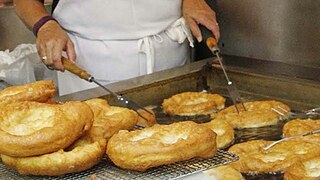
Malassada is a Portuguese fried pastry from the Azores. It is a type of doughnut, made of flattened rounds of yeasted dough, coated with sugar and cinnamon or accompanied with molasses.
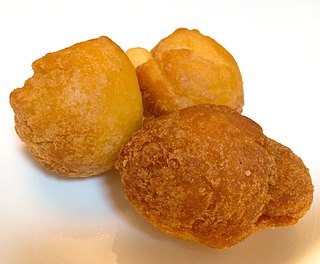
Sata andagi are sweet deep fried buns of dough similar to doughnuts, native to Southern China, there named sa-yung, then spread to the Japanese prefecture of Okinawa. They are also popular in Hawaii, sometimes known there simply as andagi. Sata andagi is made by mixing flour, sugar and eggs. The ingredients are mixed into a ball and deep fried.

Rosette are thin, cookie-like fritters made with iron molds that are found in many cultures. They are crispy and typified by their lacy pattern.

Sfenj is a Maghrebi doughnut: a light, spongy ring of dough fried in oil. Sfenj is eaten plain, sprinkled with sugar, or soaked in honey. It is a well-known dish in the Maghreb and is traditionally made and sold early in the morning for breakfast or in the late afternoon accompanied by tea—usually Maghrebi mint tea—or coffee. The term Sfenj is used in Algeria and other parts of the Maghreb. It is called bambalouni in Tunisia, and Sfenj in Libya. In Morocco, the term "Sfenj" is used, also sometimes nicknamed in the literature "Moroccan doughnuts". It is also called Khfaf or ftayr in Algeria, and is sometimes also dubbed as the "Algerian doughnut".
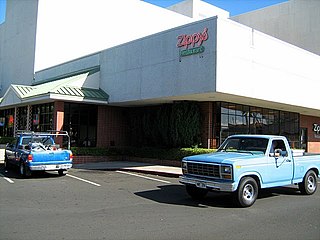
Zippy's is a fast casual restaurant chain based in Hawaii. It has 22 locations and serves American, Japanese, Chinese, and Hawaiian fusion food. One of their best-selling items is chili.
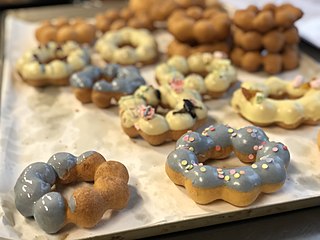
Mochi donuts, also known as poi mochi, are a fusion pastry crossing traditional American-style doughnuts and Japanese mochi. The mochi donuts' "hybrid batter makes for a doughnut that is fluffy and moist, with a satisfying chew". An early iteration can be traced back to Hawaii in the early 1990s. Mochi donuts were popularized by Mister Donut's "Pon de Ring" in the early 2000s. Mochi donuts are commonly formed into a circular shape, consisting of eight small balls that are easy to pull apart. They are made out of glutinous rice flour or tapioca flour.


















